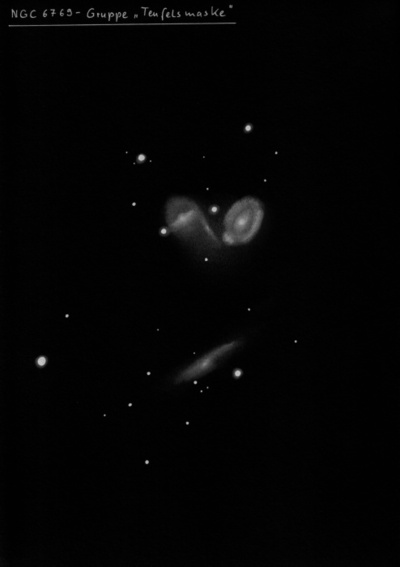
The trio is listed as an isolated southern triplet (KTS 59) by Karachentsev. The group is situated just over a degree southeast of the showpiece gc NGC 6752 and is part of the Pavo-Indus Supercluster.
John Herschel discovered NGC 6769 = h3783, along with NGC 6770 and 6771, on 11 Aug 1836 and recorded "vF; R; lbM; 20". The first of 3." His RA is 1.0 minute too small. DeLisle Stewart provided an accurate RA (given in the IC 2 Notes), based on plates at Harvard's Arequipa Station in Peru. While observing NGC 6769 on 3 Aug 1883 with the 48" Melbourne telescope, Joseph Turner discovered IC 4836, situated about 24' NW.
400/500mm - 18" (7/9/02 - Magellan Observatory, Australia): this is the brightest member and first of four in an interesting galaxy group! It appeared moderately bright and large, slightly elongated NW-SE, 1.5'x1.2'. In a close trio with NGC 6770 1.9' E and NGC 6771 3.5' SE with a 4th galaxy, IC 4842, 11' SE. On the DSS image this galaxy is clearly distorted from interacting with NGC 6770 with streamers, plumes, loops and H II regions in the outer arm. IC 4842 appeared appears fairly faint, moderately large, elongated 3:2 SSW-NNE, 1.2'x0.8', slightly brighter core. IC 4845 lies 16' NE.
600/800mm - 25" (10/17/17 - OzSky): at 244x; brightest member in a group and interacting with NGC 6770. It appeared bright, fairly large, elongated 4:3 WNW-ESE, 1.6'x1.2'. Sharply concentrated with a very bright elongated core. A mag 12.2 star is at the east edge, 0.9' ENE of center. NGC 6771 lies 3.5' SE, forming a striking triplet in a rich star field with IC 4842 11.5' SE and IC 4845 16' NE.
Notes by Steve Gottlieb